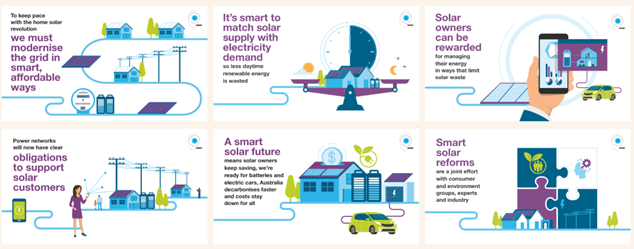Australia’s energy puzzle: Piecing together smart solar reforms
Networks are adapting to make the electricity grid smarter so it can meet changing customer needs. The modernisation of our framework isn’t without its challenges and is often a balancing act of priorities – but we can’t look at elements of a reform in isolation. Here, we take a holistic look at the export service reforms that have received recent coverage – what they do and how they benefit all customers.
Smart solar reforms
Australia’s energy system is undergoing a significant transformation. Consumer energy resources (CER) and networks are central to the delivery of a least cost transition and it’s crucial that we integrate these technologies properly to meet changing customer needs.
To ensure that more customers can embrace and benefit from CER such as solar, batteries and EVs, the Australian Energy Market Commission (AEMC) made a milestone reform in 2021 that recognised that the fundamental role of the distribution grid has changed from a simple ‘one-way’ flow to a ‘two-way’ flow grid – one where customers both consume electricity from the grid (‘consumption/import services’) and also export electricity back to the grid (‘export services’).
This modernisation of our framework was done following deep cross-collaboration and rule change requests from consumer and environmental groups, along with industry, that recognised that the rules were not designed for CER in mind and changes were needed.
The reform has had its share of headlines recently on the introduction of flexible two-way pricing, but it’s important we don’t look at just one piece of the jigsaw in isolation – the reform:
- places strict obligations on distributors to provide export services that customers value. Customers can now request and receive export services, whereas the old framework only required distributors to offer one-way import services to customers and allowed export bans,
- mandates that distributors provide a free minimum level of export to the grid for customers,
- enables the optional (but not mandated) development of pricing that rewards owners of CER for sending power to the grid when it is needed and charging them for sending power when it is not (export pricing), and
- requires any export pricing to be introduced under strong customer safeguards – extensive consultation with customers is required, an export transition strategy must be developed and final approval of any tariffs by the regulator is required before implementation, ensuring that it delivers a long-term benefit to customers.
Under this reform, distributors continue to operate under a revenue cap enforced by the regulator. This means any export tariffs introduced will not increase a distributor’s revenue. Introduction of new tariffs do not make more money for distributors under a revenue cap, but instead they change how different customers contribute to recovering the costs of the network the community shares. The reform provides options to improve equity and makes best use of infrastructure at the lowest costs for all customers.
If export services were instead made mandatory without allowing for optional export pricing, all future network investment in this area would be paid for by increasing the network consumption tariffs (i.e. the prices customers pay to import electricity).
This would mean that:
- non-solar customers would end up paying a higher share of this cost than solar customers, and
- solar customers would have not have the signals needed to allow the community to make the best use of the network, which will tend to result in costly over-investment in the network in the long term.
To avoid these outcomes, some networks in Australia have obtained regulatory approval to start to move towards introducing charges on exports in the future. This may mean that in some cases, the amount retail customers are paid overall for sending their exports to the grid will be slightly reduced.
Figure 1: Designing a smarter energy system
Progressing tariff reform
More broadly, network tariff reform, in collaboration and consultation with customers, is a key priority for regulators and distributors. As highlighted by the regulator, network tariff reform encourages more efficient use of the shared network by, for example, incentivising customers to shift load to off-peak periods where possible, which then helps reduce the need for additional investment and/or the amount of network infrastructure that needs to be maintained. This then leads to lower network costs for all customers in the long run.
To assist with progressing reform, distributors run a range of innovative network tariff trials, including[i]:
- Jemena: a community battery tariff trial for batteries with capacity up to 500 kVA. The purpose of this trial is to gain insights into the behaviour of battery operators in response to price signals.
- Ausgrid: a super off-peak tariff trial with an additional 4-hour ‘super off-peak’ charge, used to encourage EV owners to charge their EVs away from the network peak.
- Essential Energy: trial tariffs aimed at large businesses – a sun soaker, two-way tariff trial and a weekly demand tariff trial. These trials are specifically aimed at helping customers with peaky loads, such as irrigators and EV charging stations, to manage their loads.
Consumer safeguards are key
Network tariffs are just one part of the electricity ‘cost stack’, and therefore the end retail tariff that customers pay may not directly reflect the network tariff.
Energy can be complex and there is recognition that more needs to be done to engage customers and earn social licence during this energy transition. As part of this, the AEMC is seeking to strengthen customer protections and safeguards as part of the proposed accelerated roll out of smart meters, including increasing the retailer notification requirements ahead of tariff changes and the provision of additional information to customers.
Networks are adapting to make the electricity grid smarter so it can support increasing amounts of rooftop solar, storage and other devices, giving customers greater choice about how to manage their energy use, while also supporting all customers through the transition. A future-proofed charging framework with equity for all customers at the heart is key to achieving this.
[i] Source: AER 2023 State of the Energy Market, Section 4.8.1

